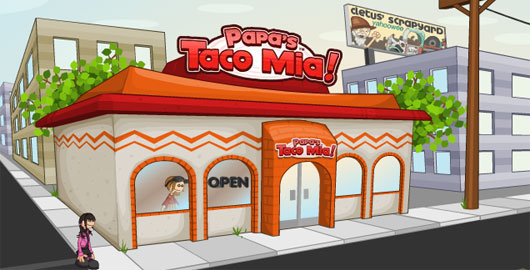A couple of years ago, my little brother, a self-professed online game addict, introduced me to a series of point-and-click games with a common theme: food preparation. These games included
Papa's Pizzeria,
Papa's Burgeria, and
Papa's Taco Mia, among many other variations! Your role in each of these games is the same. You are a worker at a fast food franchise (a pizzeria, taco shop, burger place, etc...) and your goal is to earn tip money by taking and accurately fulfilling your customers orders. The funny thing was that although I used to work at a fast food restaurant and did not enjoy it, there was something about these games that kept me playing one round after another.
"One of the defining attributes of any game," says
Zac Hill in a post entitled
Sculpting Flow and Fiero, "is that it is, in some sense, voluntary work." He goes on to say that there is something about the way games make people feel that intrinsically motivates people to continue doing this "voluntary work," whether that work is killing zombies, figuring out a way to escape a room, or making virtual tacos. I think it must be this realization that is, at least in part, behind the recent trend toward
Gamification in education, business, and other arenas.
The nonprofit organization
Educause describes gamification as "the application of game elements in non-gaming situations, often to motivate or influence behavior." In
7 Things You Should
Know About Gamification it describes how games provide intrinsic motivation to their participants by offering immediate feedback, an appropriate level of challenge, and rewards. A rationale behind the move towards gamification in the field of education specifically is that incorporating game-like elements like these into teaching holds promise for creating more intrinsic motivation for our students to learn as well as helping them see coursework less as a chore and more as a challenge.
In light of the move towards both gamification and the integration of technology in current educational practice, some instructors might decide to incorporate not just game-like elements but computer games themselves into their classroom instruction. This brings us back to the example of
Papa's Burgeria.
I imagine an adult ESL instructor seeking to incorporate more technology and more game-like elements into her classroom might choose to use a game like
Papa's Burgeria during a unit on employment and food services. The language objectives of using this game in the classroom could be for students to practice giving and receiving commands using the correct command form of verbs and food preparation vocabulary. For many refugees and immigrants, their first job in the US could likely be in the area of food preparation, which would make a knowledge of this vocabulary relevant. In an ESL classroom with a computer lab, pairs of partners could play this game together, taking turns giving commands to each other.
In order to prepare her students to play this game, the instructor could introduce vocabulary such as hamburger, lettuce, ketchup, pick up, and flip to her students and have them practice it using TPR or other similar activities. When introducing food vocabulary, she might use both photographs of the actual items as well as the visual representation used for these items in the game, to help students make the connection between the real item and its "cartoon" version. She could then have them pair up with a partner and go to a computer. One partner would play the game while the other partner gave him or her instructions on what to do, based on each customer's order (ie. pick up the bun, flip the burger, add ketchup, etc...) After each round, students could switch roles so that both partners would have the opportunity to practice both giving and receiving commands. During the activity, the instructor could circulate around the room, using a checklist to mark off whether each of the students giving instructions was using the correct verbs and nouns matching the images on the screen.


The reason I write about this example in third person is that although I consider it a way of incorporating game-like elements and technology into the language classroom, I would have reservations about actually using an activity like this with the students I teach. Most of the refugee adult students I teach have had and continue to have limited exposure to technology. Using a computer for them, period, is something scary and challenging and not very comfortable. I have a hard time seeing them pick up a new computer game as easily and effortlessly as their thirteen-year-old son would, for example. I'm afraid that rather than creating a positive atmosphere, a computer game like
Papa's Burgeria might result in anxiety and frustration, raising the affective filter and taking away from their language learning experience. I also worry that providing students with all the background information needed to play a game like this successfully may just take up too much classroom time to be worth the potential language gains that may result from it.
All that to say, while computer games may not be the best fit for the adult refugee ESL class room, I do think there are many
game-like elements such as maintaining an appropriate level of challenge, giving immediate feedback, and even providing opportunities for some healthy classroom competition that
can be a great way of increasing motivation and success experienced by refugee adult learners.




















